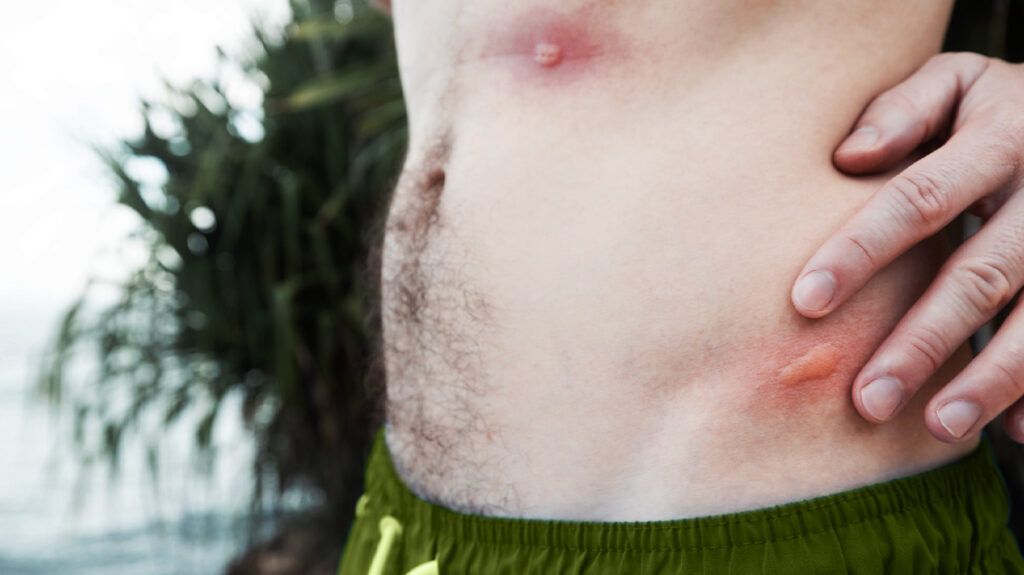Leishmaniasis is an infection from Leishmania parasites. It is transmitted through the bite of sand flies that have the parasite. An infection can be cutaneous, mucosal, or visceral.
There are
Certain cases of uncomplicated cutaneous leishmaniasis may go away on their own, but leishmaniasis can result in lifelong scarring. However, many cases of cutaneous and all cases of mucosal and visceral leishmaniasis need treatment.
Keep reading to learn more about leishmaniasis, including its forms, symptoms, causes, risk factors, diagnosis, treatment, outlook, and prevention.

The cause of leishmaniasis is an infection with the Leishmania parasite. It is
Most people with a Leishmania parasite infection will not have symptoms. When symptoms do occur, it is known as leishmaniasis.
Only a small percentage of people with the infection develop leishmaniasis.
People with weakened immune systems, such as those with HIV, may be more at risk of developing leishmaniasis.
People of all ages are at risk of leishmaniasis if they travel to or live in areas where Leishmania parasites are present. This includes parts of southern Europe, the tropics, and the subtropics. The likelihood of receiving a bite is highest from dusk to dawn, when sand flies are most active.
Leishmaniasis is known as New World leishmaniasis when the disease is found in certain regions of Mexico or Central and South America.
When it is found in parts of Asia, North Africa, the Middle East, or tropical regions of Africa, it is known as Old World leishmaniasis. Different Leishmania species can lead to them.
Most people who have leishmaniasis in the United States contract it when in other parts of the world.
Still, leishmaniasis is endemic in the United States,
The forms of leishmaniasis include cutaneous, mucosal, and visceral.
Cutaneous
Cutaneous infections are the most common. Manifestations of a cutaneous infection begin weeks to months after transmission. It involves lesions on the part of the skin where the sand fly bite occurred, typically affecting an exposed body part, such as a leg, arm, or the face.
Mucosal
The mucosal form of leishmaniasis
This form may involve a skin lesion that heals, but years or decades later, mucous membranes are affected.
Mucosal leishmaniasis can affect people who either do not receive treatment or receive inadequate treatment.
Visceral
Visceral leishmaniasis is the most severe form.
Two species of parasites can cause this form. These species are
Symptoms of leishmaniasis depend on the form.
Cutaneous
The skin lesions are typically painless. They may be:
- papules, or bumps
- nodules, which are raised, solid bumps
- ulcers, which are open eroded areas
- plaques, which are spread out, raised lesions
They may change in size and be either moist or dry. Healing may occur over the course of 6 to 18 months, but scars usually remain.
Mucosal
The first symptoms may be persistent nose stuffiness or bleeding from the nose. Later, it can cause partial to total destruction of mucous membranes of the nose, mouth, and throat.
Nasal obstruction can also occur, and complications progressively worsen.
Visceral
This form can range from having no symptoms to severe symptoms.
Symptoms may involve repeated sessions of:
- weakness
- unexplained weight loss or severe wasting
- prolonged fever
- liver and spleen enlargement
- low levels of platelets, white blood cells, and red blood cells, the latter of which may cause:
- tiredness
- shortness of breath
- paleness
- fast or irregular heart rate
Doctors base a diagnosis partly on a medical history and physical examination. The gold standard for diagnosis
- skin lesions
- nose or mouth lesions
- bone marrow
Additionally, a doctor may order blood tests to check for antibodies against the parasites. Antibodies are specialized proteins that the immune system makes to fight infection.
Doctors
The cutaneous form
Certain cases of cutaneous leishmaniasis require treatment. The treatment depends on the person’s medical history, risk of mucosal disease, and symptoms.
Treatment of small skin lesions may involve the application of heat or cold to the sores and
For people with larger skin lesions and the mucosal or visceral form, treatment may include medications such as:
- miltefosine (Impavido)
- liposomal amphotericin B (AmBisome)
- sodium stibogluconate, a drug that contains antimony, a chemical element
azoles
Surgery may be necessary for severe complications that affect mucous membranes of the nose and mouth.
A person’s outlook depends on various factors, such as the form of leishmaniasis and whether they receive treatment.
While cutaneous leishmaniasis
Conversely, if untreated, the mucosal form can lead to partial or complete destruction of mucous membranes of the mouth and nose, which can result in severe disability.
In some cases, the destruction that mucosal leishmaniasis causes can lead to death from respiratory obstruction or aspiration pneumonia, according to a
The outlook for people with untreated visceral leishmaniasis is not favorable.
What is the mortality rate of leishmaniasis?
If untreated, the visceral form can cause death in more than 90% of cases, according to the Pan American Health Organization. With treatment, it causes death in
The
When outdoors:
- Apply insect repellant to exposed skin.
- Minimize exposed areas of skin by wearing socks, long pants, and long-sleeved shirts.
When indoors:
- Remember that sand flies are much smaller than mosquitoes and can get through smaller holes.
- Stay in well-screened areas.
- Spray the living and sleeping areas with an insect repellant.
- If not sleeping inside a well-screened area, use a bed net and tuck it under the mattress.
Leishmaniasis is an infection that can take three forms. The cutaneous form affects the skin while the mucosal form involves the membranes of the nose and mouth. The visceral form affects the internal organs.
Leishmaniasis develops when a person contracts an infection with Leishmania parasites. This can occur when an infected sand fly bites them.
The gold standard of diagnosis entails finding the parasites under microscopic examination of a biopsy or tissue sample.
Cutaneous leishmaniasis may not need treatment, but the other forms do. Treatment
Prevention includes staying within well-screened areas.
